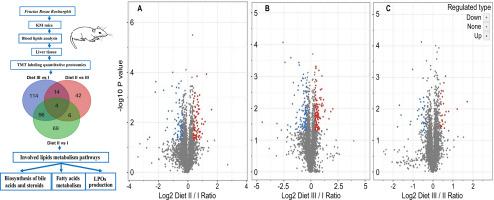Journal of Proteomics ( IF 2.8 ) Pub Date : 2020-09-11 , DOI: 10.1016/j.jprot.2020.103982 Pingping Song 1 , Xiangchun Shen 1

|
Fructus Rosae Roxburghii (FRR) has been considered as edible and medicinal fruit possessing antiatherosclerotic effect, but the mechanism is still unclear. HLP is material basis for AS formation. Under FRR action, TC, TG, LDL, HDL and ASI in serum were regulated to control level. Differentially expressed proteins in liver were analyzed by using TMT labeling and LC-MS/MS for better understanding the effect and molecular mechanism of FRR on diet-induced hyperlipidemic mice. In total, 4460 proteins were quantified, of which 469 proteins showed dramatic changes between each group. According to molecular functions, 25 differentially co-expressed proteins were divided into five categories: substance metabolism, energy transformation and signal transduction, transcription and translation, immune defense. 15 key proteins involved lipids metabolism, which were identified as Cyp7a1, Cyp3a11, Tm7sf2, COAT2, CSAD, RBP3, Lpin1, Dhrs4, Aldh1b1, GK, Acot 4, TSC22D1, PGFS, EHs, GSTM1. This suggested that FRR could maintain metabolic homeostasis by regulating the metabolism of fatty acids, biosynthesis of BAs and steroids, and production of LPOs. 20 oxidative lipids further confirmed their importance regulating lipids metabolism. It's first time potential antiatherosclerotic mechanism of FRR regulating blood lipids was explored from protein level, which is of great significance to explore new drug targets for AS.
Significance
Under the action of FRR juice, the blood lipids in mice were regulated to control level. By TMT proteomic analysis, the effect and molecular mechanism of FRR on diet-induced hyperlipidemic mice were further explored. 25 differentially co-expressed proteins obtained in three diet groups might cooperatively regulate the lipids metabolism and hepatic function of mice, thus maintaining the metabolism homeostasis. By lipidomics analysis, 20 oxidative lipids further confirmed the importance of ω-3 and ω-6 PUFAs in regulating the lipids metabolism. These findings provide an improved understanding for the regulation of FRR on the blood lipids and explores potential metabolic targets for AS prevention.
中文翻译:

刺梨作用下饮食诱导的高脂血症小鼠肝脏的蛋白质组学分析。
蔷薇(FRR)一直被认为是具有抗动脉粥样硬化作用的食药用水果,但其作用机制尚不清楚。HLP是AS形成的物质基础。在FRR作用下,血清中的TC、TG、LDL、HDL和ASI被调节到控制水平。通过使用TMT标记和LC-MS/MS分析肝脏中差异表达的蛋白质,以更好地了解FRR对饮食诱导的高脂血症小鼠的作用和分子机制。总共对 4460 种蛋白质进行了定量,其中 469 种蛋白质在各组之间表现出显着变化。根据分子功能,将25种差异共表达的蛋白质分为五类:物质代谢、能量转化与信号转导、转录与翻译、免疫防御。15种关键蛋白质涉及脂质代谢,它们被确定为 Cyp7a1、Cyp3a11、Tm7sf2、COAT2、CSAD、RBP3、Lpin1、Dhrs4、Aldh1b1、GK、Acot 4、TSC22D1、PGFS、EHs、GSTM1。这表明 FRR 可以通过调节脂肪酸代谢、BA 和类固醇的生物合成以及 LPO 的产生来维持代谢稳态。20 种氧化性脂质进一步证实了它们在调节脂质代谢方面的重要性。首次从蛋白水平探讨FRR调节血脂的潜在抗动脉粥样硬化机制,对探索AS的新药靶点具有重要意义。20 种氧化性脂质进一步证实了它们在调节脂质代谢方面的重要性。首次从蛋白水平探讨FRR调节血脂的潜在抗动脉粥样硬化机制,对探索AS的新药靶点具有重要意义。20 种氧化性脂质进一步证实了它们在调节脂质代谢方面的重要性。首次从蛋白水平探讨FRR调节血脂的潜在抗动脉粥样硬化机制,对探索AS的新药靶点具有重要意义。
意义
在FRR汁的作用下,小鼠的血脂被调节到控制水平。通过TMT蛋白质组学分析,进一步探讨了FRR对饮食诱导的高脂血症小鼠的作用及其分子机制。在三个饮食组中获得的 25 种差异共表达的蛋白质可能协同调节小鼠的脂质代谢和肝功能,从而维持代谢稳态。通过脂质组学分析,20 种氧化性脂质进一步证实了 ω-3 和 ω-6 PUFA 在调节脂质代谢中的重要性。这些发现为 FRR 对血脂的调节提供了更好的理解,并探索了预防 AS 的潜在代谢靶点。











































 京公网安备 11010802027423号
京公网安备 11010802027423号